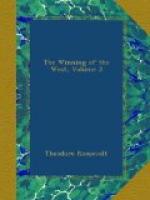Striking Contrasts in our Indian Wars.
The history of our warfare with the Indians during the century following the close of the Revolution is marked by curiously sharp contrasts in the efficiency shown by the regular troops in campaigns carried on at different times and under varying conditions. These contrasts are due much more to the difference in the conditions under which the campaigns were waged than to the difference in the bodily prowess of the Indians. When we had been in existence as a nation for a century the Modocs in their lava-beds and the Apaches amid their waterless mountains were still waging against the regulars of the day the same tedious and dangerous warfare waged against Harmar and St. Clair by the forest Indians. There were the same weary, long-continued campaigns; the same difficulty in bringing the savages to battle; the same blind fighting against hidden antagonists shielded by the peculiar nature of their fastnesses; and, finally, the same great disparity of loss against the white troops. During the intervening hundred years there had been many similar struggles; as for instance that against the Seminoles. Yet there had also been many struggles, against Indians naturally more formidable, in which the troops again and again worsted their Indian foes even when the odds in numbers were two or three to one against the whites. The difference between these different classes of wars was partly accounted for by change in weapons and methods of fighting; partly by the change in the character of the battle grounds. The horse Indians of the plains were as elusive and difficult to bring to battle as the Indians of the mountains and forests; but in the actual fighting they had no chance to take advantage of cover in the way which rendered so formidable their brethren of the hills and the deep woods. In consequence their occasional slaughtering victories, including the most famous of all, the battle of the Rosebud, in which Custer fell, took the form of the overwhelming of a comparatively small number of whites by immense masses of mounted horsemen. When their weapons were inferior, as on the first occasions when they were brought into contact with troops carrying breech-loading arms of precision, or when they tried the tactics of downright fighting, and of charging fairly in the open, they were often themselves beaten or repulsed with fearful slaughter by mere handfuls of whites. In the years 1867-68, all the horse Indians of the plains were at war with us, and many battles were fought with varying fortune. Two were especially noteworthy. In each a small body of troops and frontier scouts, under the command of a regular army officer who was also a veteran Indian fighter, beat back an overwhelming Indian force, which attempted to storm by open onslaught the position held by the white riflemen. In one instance fifty men under Major Geo. H. Forsyth beat back nine hundred warriors, killing or wounding double




